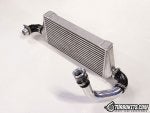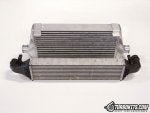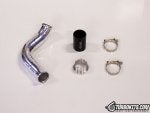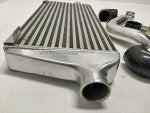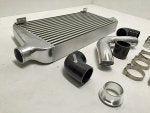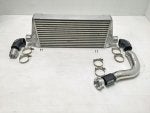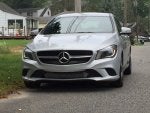After countless hours of design and months of testing our CLA 250 Front Mount Intercooler Upgrade Kit is ready for the masses! We're talking 20 HP and 23 Ft Lbs of torque at the wheels over the heat soaked stock unit, we're talking 50% decrease in air intake temps (AITs) resulting in not only more, but safer power for the motor. The turbo loves it, the ECU loves it and you will definitely love this new found power! As a matter of fact, the ECU loves the cooler charge so much, that is allows gains of 50 Wheel HP, yes that's 5 - 0 Wheel HP in the higher RPMs! (If the DYNO hadn't proved it, we wouldn't have believed it ourselves).
Our Mercedes-Benz CLA 250 Front Mount Intercooler Kit (FMIC) starts with a huge 24.0"x11.78"x3.0" bar and plate core. The leak tested core utilizes the same fin height for both internal and external rows with the external fins being louvered and offset from the internal fins. While this design has better heat transfer capabilities, pressure drop can increase. Normally, we would use plain style fins for the internal passages, especially on such a long core (24" long), however, we were able to help with the pressure drop by increasing the fin height from 0.25" to 0.375", resulting in outstanding cooling characteristics while maintaining minimal pressure drop. To further disperse the turbo air charge evenly across the entire core, we cast an internal splitter in the end tanks which also increases velocity. What is the result? A 50% reduction in air intake temps, gains reaching to 25HP and 25TQ above a heat soaked stock unit, and optimized engine efficiency through a colder, denser air inlet charge which the stock ECU will account for. Real gains of 50+ HP above 4500 RPM! All from an intercooler upgrade that is unmatched in performance and value!
Ok I want it, but what about installation? I don't want to tear my car apart!
- Don't worry, once the bumper is removed (very easy), the intercooler can be installed in roughly an hour. Actually, the DYNO testing and installation of our FMIC was done without unstrapping the car from the DYNO! Not only did we do this to prove the ease of installation, but also to guarantee the most accurate DYNO results. It also shows how easy it it to return to stock if you ever needed.
*Fits standard front bumper
*Fits AMG front bumper
*Fits FWD and 4Matic
*May fit A250, GLA 250 as well, we are working on confirmation!
TurboKits.com CLA 250 FMIC Kit Includes:
Massive 24.0"x11.78"x3.0" Intercooler Core
Mounting Brackets & Hardware
TK.com Exclusive Turbo Baffle Delete Adapter = Less turbulent air flow and a little more of that turbo sound!
Billet CNC OEM Style Piping Adapter
Turbo Hot Side Aluminum Charge Pipe
(2) 90* 4 Ply Silicone Couplers
(6) Stainless T-Bolt Clamps
Step by Step Installation Instructions
CLA 250 Front Mount Intercooler Kit - FMIC for 2014-2019 Mercedes-Benz CLA 250, GLA 250, FWD & 4Matic
*We have 25 units in stock, ready to ship.
![]()
![]()
![]()
![]()
![]()
![]()
![]()
![]()
![]()
![]()
Our Mercedes-Benz CLA 250 Front Mount Intercooler Kit (FMIC) starts with a huge 24.0"x11.78"x3.0" bar and plate core. The leak tested core utilizes the same fin height for both internal and external rows with the external fins being louvered and offset from the internal fins. While this design has better heat transfer capabilities, pressure drop can increase. Normally, we would use plain style fins for the internal passages, especially on such a long core (24" long), however, we were able to help with the pressure drop by increasing the fin height from 0.25" to 0.375", resulting in outstanding cooling characteristics while maintaining minimal pressure drop. To further disperse the turbo air charge evenly across the entire core, we cast an internal splitter in the end tanks which also increases velocity. What is the result? A 50% reduction in air intake temps, gains reaching to 25HP and 25TQ above a heat soaked stock unit, and optimized engine efficiency through a colder, denser air inlet charge which the stock ECU will account for. Real gains of 50+ HP above 4500 RPM! All from an intercooler upgrade that is unmatched in performance and value!
Ok I want it, but what about installation? I don't want to tear my car apart!
- Don't worry, once the bumper is removed (very easy), the intercooler can be installed in roughly an hour. Actually, the DYNO testing and installation of our FMIC was done without unstrapping the car from the DYNO! Not only did we do this to prove the ease of installation, but also to guarantee the most accurate DYNO results. It also shows how easy it it to return to stock if you ever needed.
*Fits standard front bumper
*Fits AMG front bumper
*Fits FWD and 4Matic
*May fit A250, GLA 250 as well, we are working on confirmation!
TurboKits.com CLA 250 FMIC Kit Includes:
Massive 24.0"x11.78"x3.0" Intercooler Core
Mounting Brackets & Hardware
TK.com Exclusive Turbo Baffle Delete Adapter = Less turbulent air flow and a little more of that turbo sound!
Billet CNC OEM Style Piping Adapter
Turbo Hot Side Aluminum Charge Pipe
(2) 90* 4 Ply Silicone Couplers
(6) Stainless T-Bolt Clamps
Step by Step Installation Instructions
CLA 250 Front Mount Intercooler Kit - FMIC for 2014-2019 Mercedes-Benz CLA 250, GLA 250, FWD & 4Matic
*We have 25 units in stock, ready to ship.


